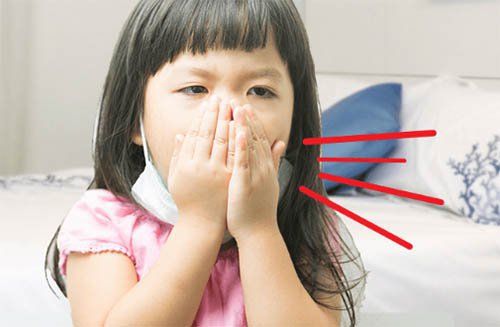This is an automatically translated article.
Posted by Doctor Ngo Van Dan - Neonatology Department - Vinmec Times City International Hospital
Tachypnea is a respiratory symptom, infants have unstable breathing, sometimes fast and sometimes slow because the nervous system controlling breathing is not yet complete. An important feature of transient tachypnea is that the infant's breathing rate is faster than normal.
1. What causes transient tachypnea?
Fetal lungs are different from neonatal lungs because the alveolar lumen contains fluid, there is no function of gas exchange, but the fetus receives nutrients and oxygen through the placenta. During labor, the fluid in the baby's alveoli will be completely absorbed, facilitating good postpartum respiration. However, the absorption of lung fluid can be affected by the following reasons:
Babies born by cesarean section, especially elective cesarean sections (not yet in labor) Premature babies: Common in late preterm infants (from 34 to 36 weeks of pregnancy), due to an immature respiratory system, health is worse than a full-term baby Mother has gestational diabetes Mother has bronchial asthma Some cases occur in babies born naturally too quickly Babies with high birth weight large or small weight for gestational age

2. Signs of transient rapid breathing?
An important feature of transient tachypnea is that the infant's breathing rate is faster than normal. The normal breathing rate of a newborn is between 40-60 breaths/minute. To ensure accuracy, you should count your breaths 2-3 times. In this disease, the breathing rate is usually higher than 60 times / minute, in some cases, the child can breathe up to 120 times / minute.
In addition to rapid breathing, the child may also have other symptoms
Chest indrawing: It can be recognized by observing the chest-abdomen, because newborns are mainly abdominal breathing, so the chest area can be seen- belly concave after the child inhales. Purple nose wings: New-born babies' limbs may be purple at first because the vasomotor system is not good, so purple signs should be observed in the lip area. Usually these children will have blood oxygen saturation (SpO2) measured and will find it lower than 95%. Groaning: This indicates that the child is trying to retain air in the lungs, one of the signs of severe

3. Is it okay for babies to breathe fast?
Tachypnea is a respiratory symptom, infants have an unstable breathing rate, sometimes fast and sometimes slow because the nervous system controlling breathing is not yet complete, and the child breathes mainly through the nose, but the infant stage is young. stuffy nose. Breathing properties of the newborn: The breathing cycle is characterized by rapid and deep breathing followed by slow and shallow breathing.
If the baby has intermittent fast breathing, is still feeding well, has gained weight well, has no other pathological symptoms, it is still within physiological limits and gradually the baby's breathing rate will stabilize. But if the baby's breathing is fast and accompanied by signs such as: Poor feeding, fever, shortness of breath, cough, cyanosis, etc., parents need to take the baby to a medical facility for timely examination and treatment.

4. Newborns breathing fast what to do?
When the family sees the infant breathing rapidly, it is necessary to pay attention to the following points:
Need to count the baby's breathing again: To ensure accuracy, it is necessary to count the breaths at least 2 times, at least 10 minutes apart. close to the abdomen (each time breathing, the abdomen expands as 1 beat), count for 1 minute, put the child in a comfortable position, lie still, do not cry. Monitor whether the baby has other accompanying signs or not? If the child is accompanied by abnormal signs such as: eating less than usual, fever, cough, difficulty breathing, purple limbs, lethargy, etc., the family needs to take the child to a medical facility immediately. The pediatric department at Vinmec Times City International General Hospital is the address for receiving and examining respiratory diseases that infants and young children are susceptible to: viral fever, bacterial fever, otitis media, pneumonia in children,....With modern equipment, sterile space, minimizing the impact as well as the risk of disease spread. Along with that is the dedication from the doctors with professional experience with pediatric patients, making the examination no longer a concern of the parents.
If there is a need for consultation and examination with experienced pediatricians at Vinmec. Please make an appointment at the website to be served.
Please dial HOTLINE for more information or register for an appointment HERE. Download MyVinmec app to make appointments faster and to manage your bookings easily.
Recommended video:Signs, how to care for children with upper respiratory tract infection at home
MORE:
Guide to monitor breathing to detect pneumonia Tachypnea - one of the warning signs of pneumonia in babies Is pneumonia in children contagious?














